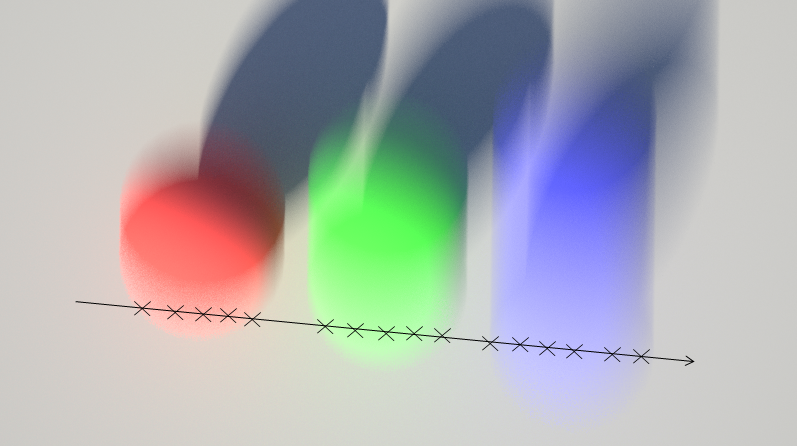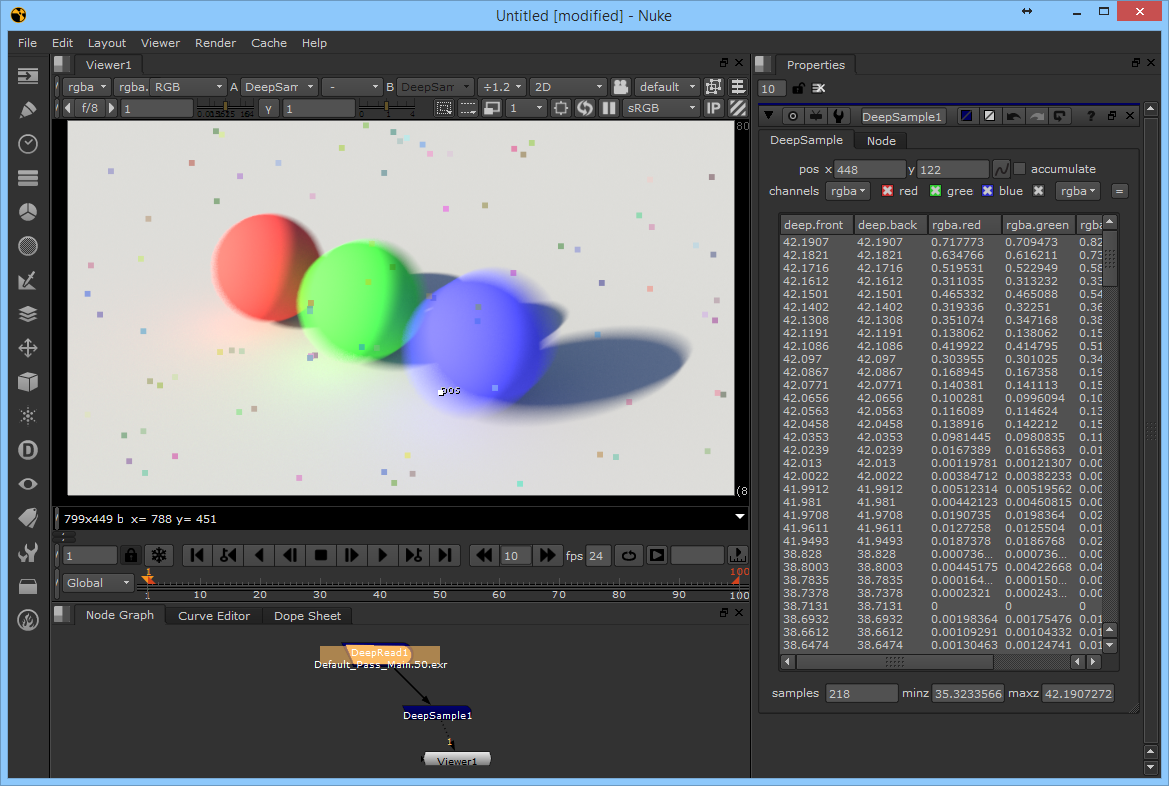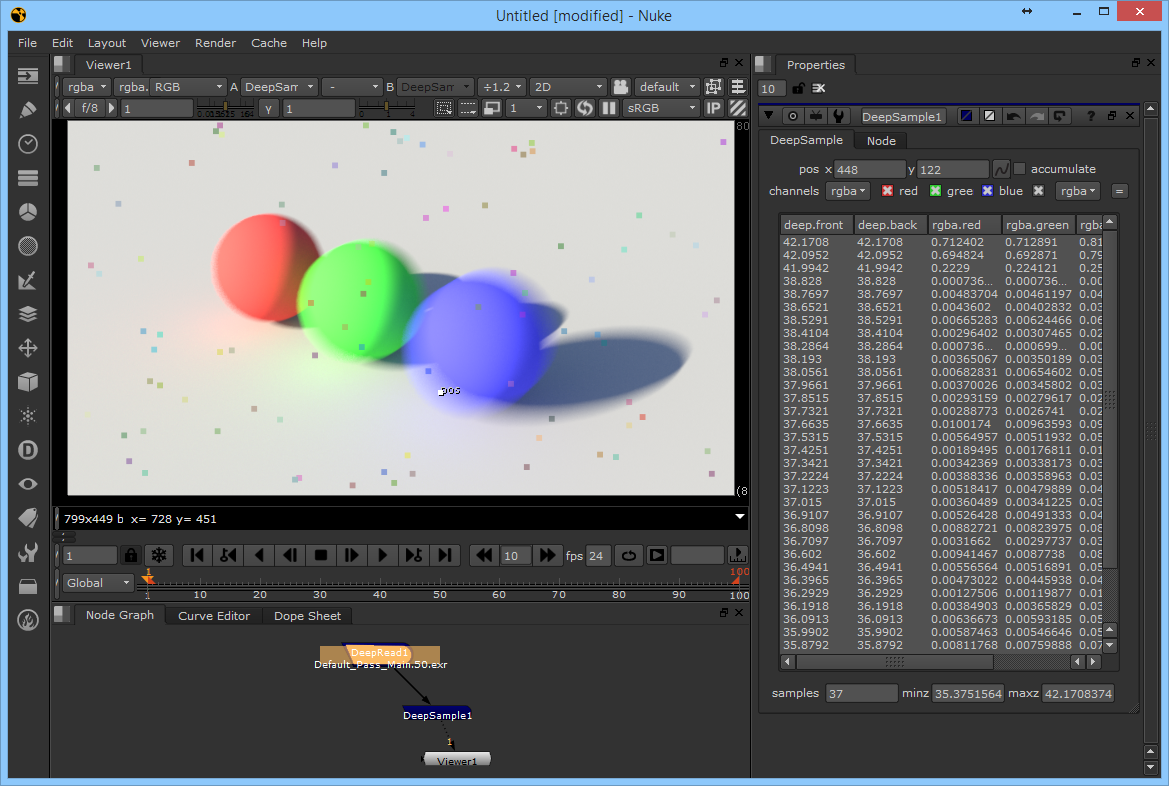Layered EXRs 分层 EXRs
Typically each AOV is written to its own image file. When working with animations, this can create file management issues. If each frame produces (say) 5 AOV images and there are thousands of frames, then there will be that many more image files on disk.
通常,每个 AOV 都被写入它自己的图像文件。当使用动画时,可能会产生文件管理问题。如果每个帧产生(比如说)5个 AOV 图像,并且有成千上万的帧,那么磁盘上将会有更多的图像文件。
Layered EXRs alleviate file management issues by allowing the combination of multiple EXRs into one.
分层的 EXRs 通过允许多个 EXRs 合并为一个来缓解文件管理问题。
Creating layered EXRs is very easy in Redshift. All you need to do is make your AOVs point to the same file. Redshift will detect this and automatically produce a single layered EXR containing all the participating AOVs.
在红移中创建分层的 EXRs 非常容易。所有你需要做的就是让你的 aov 指向同一个文件。红移将检测到这一点,并自动生成包含所有参与的 aov 的单层 EXR。
Once rendered, you can ensure your EXR contains all the necessary layers using utilities like imf_disp:
一旦渲染完成,你可以确保你的 EXR 包含所有必要的层,使用类似 imf _ disp 的工具:
…or in your comp package (Nuke shown here)
... 或在你的补给包(核弹显示在这里)
Deep EXRs
Introduction
引言
While AOVs can be powerful tools for compositing, they suffer from the fact that each pixel in a typical image can only store a single value.
虽然 aov 可以作为强大的合成工具,但是它们受到这样一个事实的困扰,即典型图像中的每个像素只能存储一个值。
This introduces a variety of issues such as:
这引入了一系列问题,例如:
- Object silhouettes can produce pixelated artifacts during the comp process. This is because the silhouette pixels are shared between multiple objects (the current object and any objects behind it). 物体剪影可以产生像素化的文物在比赛过程中。这是因为轮廓像素是在多个对象(当前对象和它后面的任何对象)之间共享的
- Depth of field and motion blur produce compositing issues because the blurred pixels are shared between multiple objects (the blurred object and any objects behind it) 景深和运动模糊产生合成问题,因为模糊像素是共享之间的多个对象(模糊对象和任何背后的对象)
- Transparencies produce issues because the final pixel is a combination of all the transparencies that contributed to that pixel. So, once again, it's a problem of multiple objects/depths contributing to the same pixel. 透明度会产生问题,因为最终的像素是对该像素有贡献的所有透明度的组合。所以,这又是一个多个物体/深度组成同一个像素的问题
As it can be seen, the main issue with all these problematic cases is the fact that multiple different objects (or depths) are all affecting the same pixel. And, because non-deep images can only store a single value per pixel, significant information is lost because of this limitation.
可以看出,所有这些问题案例的主要问题是多个不同的对象(或深度)都影响同一个像素。而且,由于非深度图像每像素只能存储一个值,因此这种限制会丢失重要信息。
Traditionally, artists solve these issues by rendering the frame in different passes in order to generate multiple images at different depth or transparency levels. This requires advance knowledge about how these passes will be used/combined and can be both laborious and wasteful in terms of rendering resources.
传统上,艺术家解决这些问题的方法是在不同的通道渲染画面,以便在不同的深度或透明度水平上生成多幅图像。这需要事先了解这些通行证将如何使用/组合,并且在渲染资源方面可能既费力又浪费。
Deep EXRs were introduced in the industry-standard EXR 2.0 specification and were designed to hold multiple values at each pixel. They, therefore, allow a wide variety of compoperations without worrying about usage of depth of field, motion blur and transparency or issues around object silhouettes.
在工业标准 exr2.0规范中引入了深 EXR,并设计成在每个像素上保存多个值。因此,他们允许各种各样的编辑操作,而不用担心景深、运动模糊、透明度或者围绕物体轮廓的问题。
The main drawback with deep EXRs is their increased file size and subsequent storage needs. The increased file size stems from the fact that multiple values ("samples") are stored for each pixel. Redshift tries to keep deep EXR files sizes as small as possible via a small set of controls discussed below.
深 EXRs 的主要缺点是增加了文件大小和随后的存储需求。文件大小的增加源于为每个像素存储了多个值(“示例”)。Redshift 尝试通过下面讨论的一小组控件来保持深 EXR 文件的大小尽可能的小。
Volume rendering is only supported with Deep output in Redshift version 3.0.32 and higher.
立体渲染只支持红移3.0.32及以上版本的深度输出。
Currently, Redshift can only store beauty, depth and objectID in deep EXR files. The remaining AOV types will be supported at a later stage. Because of this limitation, when rendering with Deep Output enabled, any AOVs (other than ObjectID) will be disabled.
目前,Redshift 只能在深 EXR 文件中存储美、深度和对象。其余的 AOV 类型将在稍后阶段得到支持。因为这个限制,当渲染启用深度输出时,任何 aov (除了 ObjectID)将被禁用。
Enabling Deep Output
启用深度输出
To enable Deep Output rendering in Cinema 4D you must first enable the render settings depicted and listed below:
为了使深输出渲染在电影4 d 你必须首先启用渲染设置描述和下面列出:
- Enable "Multi-Part EXR" under the AOV tab's General section. 在“ AOV”标签的“常规”部分启用“多部分 EXR”
- Add and enable a "Main" type AOV 添加并启用“主”类型的 AOV
- Enable "Direct Output" for your Main AOV 启用“直接输出”为您的主要 AOV
- Set the Main AOV's format to "OpenEXR" 设置主 AOV 的格式为“ OpenEXR”
- Enable "Deep Output" under the AOV tab's Processing section. 在 AOV 选项卡的处理部分启用“深度输出”
Settings necessary for Deep Output in Cinema 4D
电影4D 深度输出的必要设置
Deep Output rendering requires a Main AOV set to Direct Output in Cinema 4D.
深度输出渲染需要一个主要的 AOV 设置为直接输出在电影4D。
The Merge Sample Options
合并示例选项
As mentioned above, deep EXRs can produce large files. For this reason, most renderers contain options for merging together the multiple values of each pixel so that the file sizes can be reduced.
如上所述,深 EXRs 可以生成大文件。由于这个原因,大多数渲染器都包含合并每个像素的多个值的选项,这样可以减小文件大小。
The following options explain the different merging modes supported by Redshift and how they could be used in your scene.
下面的选项解释了红移支持的不同合并模式,以及如何在你的场景中使用它们。
Please note that too much merging means that not enough information will be preserved on the final pixels and the benefits of deep EXRs will be lost. On the other hand, too little merging means that the deep EXR files can be very large, especially for scenes using high geometrical complexity, transparency, depth of field or motion blur. Learning how to effectively use these parameters is very important in order to bring the EXR file sizes under control!
请注意,过多的合并意味着没有足够的信息将保留在最终的像素和深 EXRs 的好处将丢失。另一方面,太少的合并意味着深 EXR 文件可以非常大,特别是对于使用高几何复杂度、透明度、景深或运动模糊的场景。为了控制 EXR 文件的大小,学习如何有效地使用这些参数是非常重要的!
Redshift currently supports two Deep Merge modes: Z and ObjectID.
Redshift 目前支持两种深度合并模式: z 和 ObjectID。
Z Mode
Z 模式
The "Z" mode means that, for each pixel, depth samples that are close to each other will be merged together. The "Deep Merge Z Threshold" parameter controls how close the samples will need to be in order for them to be merged together.
“ z”模式意味着,对于每个像素,彼此接近的深度采样将合并在一起。“ Deep Merge z Threshold”参数控制样本合并到一起所需的距离。
To explain how this works, let's look at this simple scene containing a few motion blurred spheres.
为了解释这是如何工作的,让我们看看这个包含一些运动模糊球体的简单场景。
The following image shows how samples are collected by Redshift as rays are shot for a pixel. The arrow denotes a single ray shot from the camera (a 'primary ray') and the X's are the gathered samples. Each sample has its own Z which denotes how far away it is from the camera. The samples of the red sphere are the closest to the camera while the blue sphere samples are the farthest ones.
下面的图像显示了红移是如何收集样本,因为光线是为一个像素拍摄。箭头表示来自相机的一道射线(“主射线”) ,x 表示收集到的样本。每个样品都有自己的 z,表示它离相机有多远。红球样本离摄像机最近,蓝球样本离摄像机最远。
As the ray goes through the motion-blurred trails, it gathers several samples
当光线穿过运动模糊的轨迹时,它收集了几个样本
Using the Z Deep Merge mode, samples that are close to each other (in Z) are merged together. This reduces the total number of samples stored for that pixel and, subsequently, reduces the final EXR file size.
使用 z Deep Merge 模式,彼此相近的样本(在 z 中)合并在一起。这减少了为该像素存储的采样总数,并随后减少了最终的 EXR 文件大小。
To see this effect in a more practical manner, let's inspect an actual deep EXR image in Nuke. We'll use the "DeepSample" Nuke node to inspect one of the pixels.
为了看到这种效果在一个更实际的方式,让我们检查一个实际的深 EXR 图像在核武器。我们将使用“ DeepSample”核节点检查其中一个像素。
Looking at the deep data in Nuke, we realize that some pixels contain many samples in them! This is because, for this scene, the default "Deep Merge Z threshold" (0.01) was too small.
看看纽克的深层数据,我们意识到一些像素包含许多样本!这是因为对于这个场景,默认的“ Deep Merge z threshold”(0.01)太小了。
If we increase the Z threshold to 0.1 and re-render, we get fewer samples per pixel and the EXR file size is reduced considerably: 37 samples instead of 218 for the chosen pixel.
如果我们将 z 阈值提高到0.1,然后重新渲染,我们得到的每个像素的采样数量会减少,EXR 文件大小也会大大减少: 对于选定的像素,37个采样数量而不是218个。
An even larger Z threshold would have reduced the stored samples further.
更大的 z 阈值会进一步减少存储的样本。
ObjectID Mode
客观模式
The ObjectID mode will merge all samples that belong to the same objectID without caring about whether they are close to each other in Z or not. This means that, by default, the ObjectID mode performs more sample merging than the Z mode, which in turn produces significantly smaller EXR files.
ObjectID 模式将合并属于同一个 ObjectID 的所有样本,而不考虑它们在 z 中是否彼此接近。这意味着,在缺省情况下,ObjectID 模式比 z 模式执行更多的示例合并,而 z 模式又会生成更小的 EXR 文件。
The following image shows how the Z mode works for our example scene. As it can be seen, each object with a different ObjectID gets a single sample.
下面的图片展示了 z 模式在我们的示例场景中的工作原理。可以看到,具有不同 ObjectID 的每个对象只有一个样本。
To see this effect in a more practical manner, let's render the image from a lower vantage point where the sphere blurred trails overlap for a given pixel.
为了以更实用的方式看到这种效果,让我们从较低的有利位置渲染图像,这里球体模糊的轨迹对于给定的像素是重叠的。
Inspecting the actual deep EXR image in Nuke reveals that the pixel in question only contains 3 samples. That is indeed what we expected since each sphere has its own ObjectID.
检查在 Nuke 中实际的深 EXR 图像显示,问题中的像素只包含3个样本。这确实是我们所期望的,因为每个领域都有自己的目标。
While the ObjectIDDeep Merge mode produces significantly smaller EXR files, it has a few drawbacks.
虽然 objecdddeepmerge 模式产生的 EXR 文件要小得多,但它也有一些缺点。
If you try to composite together multiple deep EXRs (containing different objects), you could get visual artifacts if the objects in the different EXRs intersect each other in Z, as shown below.
如果您尝试将多个深层 EXRs (包含不同的对象)组合在一起,如果不同 EXRs 中的对象在 z 中相交,则可以得到可视化工件,如下所示。
Say you're compositing a Houdini particle system (the gray cloud in the image) stored in a deep EXR with some redshift geometry (the red boxes in th eimage) stored in another deep EXR. If the particle system intersects the Redshift geometry, the ObjectID Deep Merge mode will generate insufficient Z information and produce visual artifacts around the intersection areas during comp
假设你正在合成一个霍迪尼粒子系统(图中的灰色云) ,它存储在一个深 EXR 中,其中有一些红移几何体(图中的红色盒子)存储在另一个深 EXR 中。如果粒子系统与红移几何相交,则 ObjectID 深度合并模式将产生不足的 z 信息,并在合并过程中在交叉区域周围产生视觉伪影
On the other hand, if the particle system is clearly separated from the objects, fewer or no issues will arise.
另一方面,如果粒子系统与对象明显分离,就会出现很少或根本没有问题。
MeshID Mode
MeshID 模式
The MeshID mode will merge all samples that belong to the same meshID without caring about whether they are close to each other in Z or not. "MeshID" here refers to the unique ID Redshift internally assigns to each individual mesh in the scene. This means that, in contrast to the ObjectID mode, you don't have to manually assign IDs to object to "keep them seperate" in the deep data.
MeshID 模式将合并属于同一个 MeshID 的所有样本,而不关心它们在 z 中是否彼此接近。“ MeshID”在这里指的是独特的 ID 红移内部分配给场景中每个单独的网格。这意味着,与 ObjectID 模式相反,您不必手动将 id 分配给对象,以便在深度数据中“将它们分离”。
Except for this difference, the MeshID mode behaves exactly like the ObjectID mode and with the same pros and cons.
除了这个不同之外,MeshID 模式的行为与 ObjectID 模式完全相同,并且具有相同的优点和缺点。













赶快留个言打破零评论!~